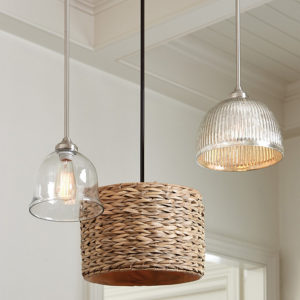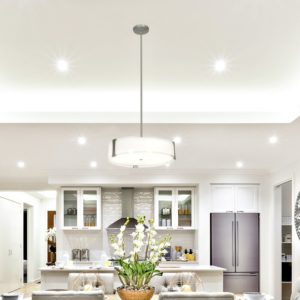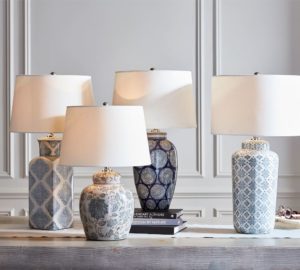It’s no secret that lighting can make or break the final design plan for any room. Lack of lighting, harsh lighting, or lighting that does not fit the overall aesthetic of the home, can turn a space into an unwelcoming hangout.
But, if you think of lighting as “jewelry” for the space, even in the most task-driven rooms, you’ll be able to create an environment that your family and friends will love.
 How you use your space should be one of the first considerations of what type of lighting you will need. Lighting for a kitchen will be much different than what you would choose for a bedroom or family room. Plan adequately for the spaces where you’ll need extra light for working. The mood of the room should also be considered when drafting your lighting plan. Areas that are used for relaxing or just hanging out may need some task lighting but should mostly rely on ambient lighting to set the mood.
How you use your space should be one of the first considerations of what type of lighting you will need. Lighting for a kitchen will be much different than what you would choose for a bedroom or family room. Plan adequately for the spaces where you’ll need extra light for working. The mood of the room should also be considered when drafting your lighting plan. Areas that are used for relaxing or just hanging out may need some task lighting but should mostly rely on ambient lighting to set the mood.
Fundamentally, there are three categories of lighting that homeowners should focus on; ambient, task, and accent lighting. Unfortunately, one of the biggest design mistakes we see are rooms that only provide one source of lighting. Ideally, each room should have multiple sources of lighting to accommodate how the space is being used. Can lights, combined with floor and table lamps are ideal for family rooms, offices, and living rooms. Pendant lights combined with can lights and cabinet lighting are ideal for kitchens and bathrooms. Again, think about how space will be used and plan accordingly so that you have several options to choose from when you are in that room.
Total wattage/lumens and color of lighting are also very important considerations for any home. Task areas tend to require more wattage than relaxation rooms. The best way to determine how much lighting you need for a room is to take the total square footage of a room and multiply it by 1.5. So if your room is 12 x 15 (180 sq ft.) you would multiply 180 x 1.5 and get to 270 watts. The general lighting in the room will need to reach a minimum of the 270 watts mark to ensure there is plenty of overall light.
 Recent trends allow for just about any kind of lighting to be mixed with different design styles. The key is to not let your lighting get overlooked. When updating a space, think beyond the hard surfaces, paint, and furniture. Many builders will typically install entry-level fixtures in order to save on cost. As the home ages, those fixtures become dated… and hated. Big box stores have several stylish lighting options for those working on a budget. You can also work with your interior designer or contractor to create a new lighting package to match your current style. No matter what you choose, just make sure all of your lighting coordinates with the overall look and feel you are trying to create.
Recent trends allow for just about any kind of lighting to be mixed with different design styles. The key is to not let your lighting get overlooked. When updating a space, think beyond the hard surfaces, paint, and furniture. Many builders will typically install entry-level fixtures in order to save on cost. As the home ages, those fixtures become dated… and hated. Big box stores have several stylish lighting options for those working on a budget. You can also work with your interior designer or contractor to create a new lighting package to match your current style. No matter what you choose, just make sure all of your lighting coordinates with the overall look and feel you are trying to create.
From chandeliers to pendant lights and everything in between, nothing is worse than walking into a room and having a light fixture overpower the space. Or be so small it looks like it was a mistake. Thankfully, some simple math will help you determine which light fixtures will be the best for your home:
Measure your room's length and width in feet and add those two numbers together. Then use that number as the width in inches for your chandelier. For example, if your room is 12' x 16', your chandelier should be 28" wide.
However, if you are placing the chandelier above a table, the width of the chandelier should be 12" narrower than the width of the table so no one bumps into it while getting in and out of their seat. Additionally, chandeliers should be placed 30 – 34 inches above a table to prevent them from interfering with site lines.
The number and placement of pendants over a stationary object are best determined based on the size of the object being highlighted. It is best to use an odd number of pendants over a table, countertop, desk, or end table. This technique creates a focal point and allows an even balance on each side. When hanging multiple pendants, the spacing should be determined by the diameter of the pendant.
Ideally, you will want the space between each pendant to be the same as the width or diameter of each fixture. For example, if you have 16-inch pendants, the space between each fixture should be 16 inches. This rule of thumb is still true, even if the pendants are hung at staggering heights. To figure out the proper size of your kitchen island pendants, follow the steps below:
 Lamps tend to come in three different categories: table, desk, and floor lamps. The height of the table lamp you pick is determined more by the room it sits in and the décor around the lamp. If you have a tall bedside table, then a shorter lamp will do and vice versa. The general norm here is to pick a lamp where the bottom of the shade is at your eye level when you are seated or resting. This works whether you are shopping for a table lamp that fits your reading nook, a bedside lamp, or even one that goes next to the couch in the living room.
Lamps tend to come in three different categories: table, desk, and floor lamps. The height of the table lamp you pick is determined more by the room it sits in and the décor around the lamp. If you have a tall bedside table, then a shorter lamp will do and vice versa. The general norm here is to pick a lamp where the bottom of the shade is at your eye level when you are seated or resting. This works whether you are shopping for a table lamp that fits your reading nook, a bedside lamp, or even one that goes next to the couch in the living room.
As a general rule of thumb, you determine how many canned lights you need by measuring the length and width of a room, as well as how high it is. Again, consider how the room will be used. We highly recommend putting all of your recessed lights on a dimmer switch so that you can modify, as needed. Additionally, consider different shades on the recessed lighting to accent walls, artwork, and other features within the room.
Still wondering what type of lighting designs will work best for your home? Feel free to contact us for an interior design service consultation or complete lighting package at info@macylanedesigns.com or via phone at 480-613-6537. We’d be honored to help you create your dream space.